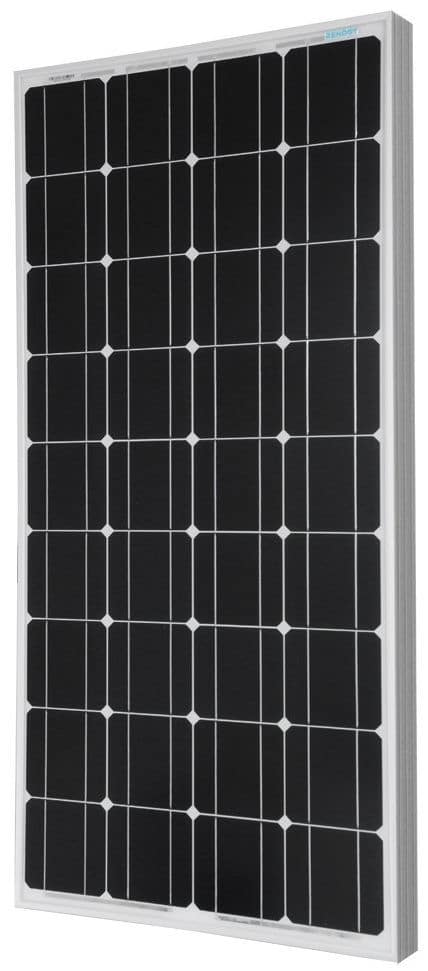
Connecting Solar Panels Together
How to Connect Solar Panels Together
![]() Connecting solar panels together is a simple and effective way of increasing your solar power capabilities. Going green is a great idea, and as the sun is our ultimate power source, it makes sense to utilize this energy to power our homes. As solar power becomes more accessible, more and more homeowners are buying photovoltaic solar panels.
Connecting solar panels together is a simple and effective way of increasing your solar power capabilities. Going green is a great idea, and as the sun is our ultimate power source, it makes sense to utilize this energy to power our homes. As solar power becomes more accessible, more and more homeowners are buying photovoltaic solar panels.
However, these photovoltaic solar panels can be very costly so buying them over time helps to spread the cost. But the problem then becomes how do we connect these extra solar panels together to increase the voltage and power output of what’s already there.
The trick here when connecting solar panels together is to choose a connection method that is going to give you the most energy efficient configuration for your particular requirements.
Connecting solar panels together can seem like a daunting task when you first start to look at how it should be done, but connecting multiple solar panels together is not that hard with a little thought. Wiring solar panels together in either parallel or series combinations to make larger arrays is an often overlooked, yet completely essential part of any well designed solar power system.
There are three basic but very different ways of connecting solar panels together and each connection method is designed for a specific purpose. For example, to produce more output voltage or to produce more current.
Solar photovoltaic panels can be electrically connected together in series to increase the voltage output, or they can be connected together in parallel to increase the output amperage. Solar pv panels can also be wired together in both series and parallel combinations to increase both the output voltage and current to produce a higher wattage array.
Whether you are connecting two or more solar panels, as long as you understand the basic principles of how connecting multiple solar panels together increases power and how each of these wiring methods works, you can easily decide on how to wire your own panels together. After all connecting solar panels together correctly can greatly improve the efficiency of your solar system.
Connecting Solar Panels Together in Series
The first method we will look at for connecting solar panels together is what’s known as “Series Wiring“. The electrical connection of solar panels in series increases the total system output voltage. Series connected solar panels are generally used when you have a grid connected inverter or charge controller that requires 24 volts or more. To series wire the panels together you connect the positive terminal to the negative terminal of each panel until you are left with a single positive and negative connection.
Solar panels in series add up or sum the voltages produced by each individual panel, giving the total output voltage of the array as shown.
Solar Panels in Series of Same Characteristics
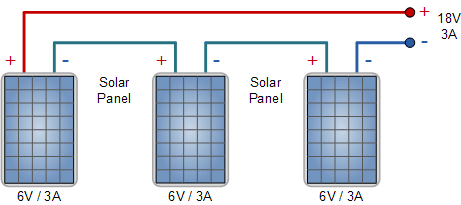
In this method ALL the solar panels are of the same type and power rating. The total voltage output becomes the sum of the voltage output of each panel. Using the same three 6 volt, 3.0 amp panels from above, we can see that when these pv panels are connected together in series, the array will produce an output voltage of 18 Volts (6 + 6 + 6) at 3.0 Amperes, giving 54 Watts (volts x amps) at full sun.
Now lets look at connecting solar panels in series with different nominal voltages but with identical current ratings.
Solar Panels in Series of Different Voltages
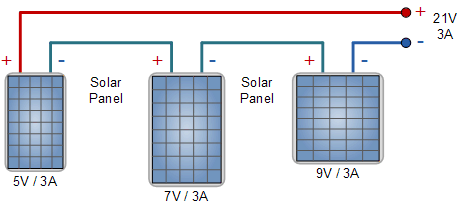
In this method all the solar panels are of different types and power rating but have a common current rating. When they are connected together in series, the array produces 21 volts at 3.0 amps, or 63 watts. Again the output amperage will remain the same as before at 3.0 amps but the voltage output jumps to 21 volts (5 + 7 + 9) .
Finally, lets look at connecting solar panels in series with completely different nominal voltages and different current ratings.
Solar Panels in Series of Different Currents
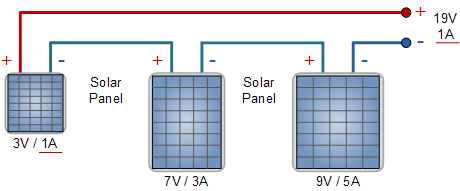
In this method all the solar panels are of different types and power rating. The individual panel voltages will add together as before, but this time the amperage will be limited to the value of the lowest panel in the series string, in this case 1 Ampere. Then the array will produce 19 Volts (3 + 7 + 9) at 1.0 Ampere only, or only 19 watts out of a possible 69 watts available reducing the arrays efficiency.
We can see that the solar panel rated at 9 volts, 5 amps, will only use one fifth or 20% of its maximum current potential reducing its efficiency and wasting money on the purchase of this solar panel. Connecting solar panels in series with different current ratings should only be used provisionally, as the solar panel with the lowest rated current determines the current output of the whole array.
Connecting Solar Panels Together in Parallel
The next method we will look at of connecting solar panels together is what’s known as “Parallel Wiring“. Connecting solar panels together in parallel is used to boost the total system current and is the reverse of the series connection. For parallel connected solar panels you connect all the positive terminals together (positive to positive) and all of the negative terminals together (negative to negative) until you are left with a single positive and negative connection to attach to your regulator and batteries.
When you connect solar panels together in parallel, the total voltage output remains the same as it would for a single panel, but the output current becomes the sum of the output of each panel as shown.
Solar Panels in Parallel of Same Characteristics
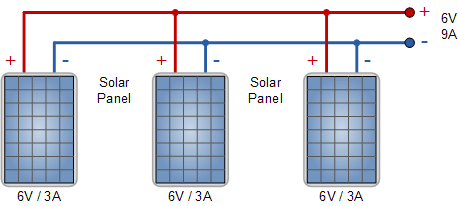
In this method ALL the solar panels are of the same type and power rating. Using the same three 6 Volt, 3.0 Amp panels as above, the total output of the panels, when connected together in parallel, the output voltage still remains at the same value of 6 volts, but the total amperage has now increased to 9.0 Amperes (3 + 3 + 3), producing 54 watts at full sun.
But what if our newly acquired solar panels are non-identical, how will this affect the other panels. We have seen that the currents add together, so no real problem there, just as long as the panel voltages are the same and the output voltage remains constant. Lets look at connecting solar panels in parallel with different nominal voltages and different current ratings.
Solar Panels in Parallel with Different Voltages and Currents
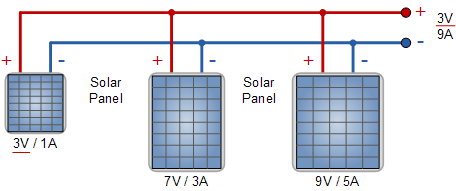
Here the parallel currents add up as before but the voltage adjusts to the lowest value, in this case 3 volts or some voltage value very close to 3 volts. Solar panels must have the same output voltage to be useful in parallel. If one panel has a higher voltage it will supply the load current to the degree that its output voltage drops to that of the lower voltage panel.
We can see that the solar panel rated at 9 volts, 5 amps, will only operate at a maximum voltage of 3 volts as its operation is being influenced by the smaller panel, reducing its efficiency and wasting money on the purchase of this higher power solar panel. Connecting solar panels in parallel with different voltage ratings is not recommended as the solar panel with the lowest rated voltage determines the voltage output of the whole array.
Then when connecting solar panels together in parallel it is important that they ALL have the same nominal voltage value, but it is not necessary that they have the same ampere value.
Connecting Solar Panels Together Summary
Connecting solar panels together to form bigger arrays is not all that complicated. How many series or parallel strings of panels you make up per array depends on what amount of voltage and current you are aiming for. If you are designing a 12 volt battery charging system than parallel wiring is perfect. If you are looking at a higher voltage grid connected system, than you’re probably going to want to go with a series or series-parallel combination depending on the number of solar panels you have.
But for a simple reference in regards to how to connect solar panels together in either parallel or series wiring configurations, just remember that parallel wiring = more amperes, and series wiring = more voltage, and with the right type and combination of solar panels you can power just about any electrical device you may have in your home.
For more information about Connecting Solar Panels Together in either series or parallel combinations, or to obtain more information about the different types of solar panels available, or to explore the advantages and disadvantages of using solar power in your home, then Click Here to order your copy from Amazon today and learn more about designing, wiring and installing off-grid photovoltaic solar electric systems in your home.





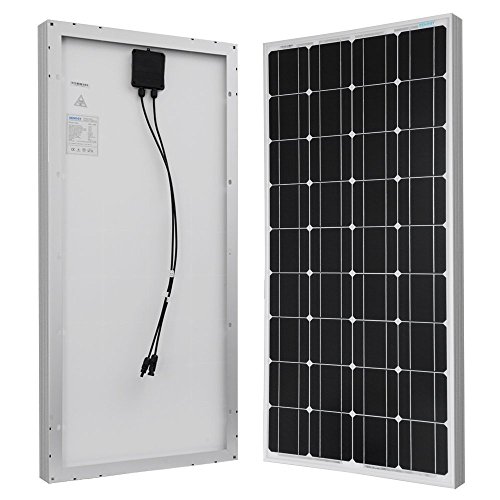





Great article and start to what the book has to offer!
I’ve just purchased 4 sunpower 305w 60v 5.58a solar panels, could you recommend the proper charge controller. At this moment I dont have and inverter or batteries, I am planning on also purchasing those items shortly.
I have 3KW inverter 48 Volt. how many 330W solar panels of 37 Volt will I use and how must I connect it to give me the 30 Amp that I need to charge the battery’s
My question is I have 5 100 watt panels 12 v rated at 3 amp each with 6 amp charge controller can I hook up in parallel each with separate charge controller to charge 2 6 v batteries in series
Yess you can connect the panels in parallel and the batteries in series to create a 12 volt system.
hello,
i have 36 panels of 300watts/75amps each and 30 batteries of 12v/200amps. what type of charge controller do i need to give 16Kva power and in what array please.
regards
lemi
Dear Admin,I am using 3 kw 48 volt solar ups which support 3000 watt panels,and as advised by the company i am using 12 solar panels of 250 watt 24 volt by pairing two solar panels each to make 48 volts ,My problem is that my mppt solar ups only shows max 30 amp at peek hours.do you thing 30 amp are sufficient to charge 4 12 volt 180 mah batteries or there is a problem in solar panels or wiring?please advice
Solar irradiance and ambient temperature affect a PV array’s voltage and current output. Charging current depends on the depth of charge of the batteries, so if the batteries only need 30 amps to charge then that is what your array will supply. We can not comment if you have a problem with your panels or wiring. Its your system you will know.
I have 20 327 watt panels at 60v and 6 amp rating. I am looking to purchase a controller Magnum 100 controller. It states optimum battery voltage is 48, Max input 190V. and 100amp rated. So could I series wire two arrays to 120vDC then parallel the two arrays so that I make a 120vdc system producing 60 watts. And then since my panels are 60 volt, still uses the 48v system on batteries instead of 60v wiring on batteries. I suppose this unit would not charge a 60 volt battery combination. Could you advise on this one? Thank you, Tex.
Two panels in series would give 120V, 6 amps per string. If you have 20 panels then you will have 10 strings giving a total array combination of 120V PV array voltage producing 60 Amps. If your controller input is rated at 190V, 100 amps max, then the proposed array is within its limits. The 48V relates to the output battery bank voltage.
Hello, I picked up a 100W 18V 5.5A panel and want to connect it with a 40W 17.1V 2.3A panel, I’m assuming it will be no more than 17.1V @ 7.8A when wired in parallel (under ideal conditions) ? Also was hoping to use the 30amp charge controller that came with the larger 100W panel, I will be using this setup on a travel trailer when off grid camping to keep batteries topped up.(2 12V 85ah deep cycle batteries wired in parallel) would this work and be equivalent to a 140W panel, ? Thank you,
Luke
It would not be equivalent to a 140W panel, no, but would be close. Connecting in parallel with blocking diodes would be the way forward.
Hi
I have 9 x 325w 48v canadian solar panels with a Victron 150/85 charge controller connected to 4 x 200ah AGM Batteries to a 48v 5000 Victron Multiplus the panels are connected 3 strings of 3 or would panels connected 2 in series be more efficient
A 9 panel array would still give you the same output power no matter how you connected them. The only difference is in total output voltage and current due to the various combinations. Check your controller manual for recommended V and I input values.
Hi,
I have 6 panels of 8.9Amp and 38.2V each making them in total 2KVA. I have currently joined them in parallel but often the amperes would go down to real low level such as 0 or 10 and the other times it give almost 40-50amps too. Now i was wondering if i need to do the connection right. My Inverter manual suggests Max PV array open circuit voltage of 102Vdc and PV Array MPPT voltage range of 30~80Vdc. It also illustrate an example of joining 2 sets of 30.1V panels in series and three in parallel.
Can i join my 2 sets in Series and 4 in parallel? i was wondering if that would even work.
The configuration of your array will depend on your inverter input requirements as detailed in your manual. The output from the array will depend on many different factors, such as the amount of irradiance, temperature and more importantly the connected load. Check your conditions and state of the load at both low and high amperage levels to understand your system better.
Hallo Admin,
I have connected 3 12V 100w panels in parallel to my solar inverter. Each panel current rating is 6.4A. The out put I am getting as about 15 V and and charge is varing from 1.1A to maximum 1.9A. It is supposed to charge at minimum of 10 A. By checking individuals panel the it is showing only 1.1 A charge. I am not able to understand the problem, Could you advice me.
Why should it charge at 10A
As per the parallel diagram given above it should be 6.4 * 3 = 19.2A. Based on sun ray intensity I expected about half of it. But I am getting very low. Could you advice me.
DV Reddy
I love this lecture on PV solar connection, is very comprehensive and educative.
I really appreciate. Please keep it up.
Thanks!
I have 2 panels wired in Parallel , I would like to check each one to confirm that they are functioning as they should. I tried covering one panel at a time and the voltage / amps does not change much . Should I disconnect one at a time to get a accurate reading from the uncovered panel or is there a better way?
Any assistance would be great
thanks Ron
You may not see much change as it is possible your panels have a built-in bypass diode for protection. The only way to check the operation of each panel is to disconnect and test them individual.
I have 2 x 100 watt panels, and 2 x 65 watt panels on a sailboat, and a Tracer 3210 MPPT controller. Should I link them in Parallel or series? or the 2 x 65 watt in Series, and the 2 x100 watt in parallel?
Again, the connection of your array will depend on the IV input power charcacteristics of your controller, inverter, or DC voltage requirements.
I have 16 Solar Panels containing 300watt in each panel while I want to have these panels with 5kv Inverter. Could you please guide that what combination of panels (like Series/Parallel) should I use?
That depends on the IV power rating of your inverter and the reason why you purchased 16, 300W panels.
hello admin, can I connect inverter to solar panel at the same time to light for charging the battery? Hope it will not cause outbreak?
Sir I have 4 solar panel of 350 watts can I use this to 24 volt system which contains 2 batteries of 12 of each volts and ups of 3kv can this system works?
Possibly, configure your panels and batteries to operate as a 24 volt system.
Can u please give me an istruction or diagram for different watts panel board…
Sir i have a question i have 300,,watts 43v panel and 250w 43v panel may solar charge controller is mppt-40A with 2 batteries 12v what connection we use.
As your panels have exactly the same Voc, connect them in parallel.
Hello, I have two separate mobile solar systems. Each system has 3 matching 50w/17v panels, a 165w controller, 4 29DC 12v batteries and 3000w rated PSW inverters. I’m wondering if occasionally I can parallel the two systems together into only one of the inverters when I dont need them to be in different locations? I really dont want to change the system in any other way if I dont have to. The battery bank will then be 8 batteries (4 each in parallel) and be charged thru two 165w controllers at the same time. Will this cause each controller to conflict and/or confuse each other somehow? Like when one controllers is charging the batteries at max, the other controller will see the voltage and shut off? Thank you
It depends on the type of chargers used. Parallel charging delivers increased amperage (amps x number of chargers) but it is advisable to use the same type of controller, MPPT and that the controllers are set with the same charging profile for voltage regulation. Also each controller’s Voltage Sense Terminal needs to be connected to the battery bank to ensure each controller is measuring the same battery bank voltage.
sir 4 panels 300 watt 2 panels 250 watt and 5 panels 150 watt and 3000 watt 48 volt ups how connect panels plz help.gaigram